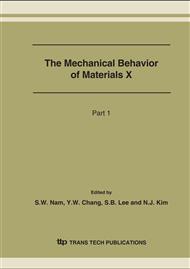p.1189
p.1195
p.1201
p.1205
p.1209
p.1213
p.1217
p.1221
p.1225
Processing and Mechanical Properties of Solid Core and Porous Surface Ti-6Al-4V Implants Fabricated by Powder-Metallurgy
Abstract:
Porous-surfaced with solid core Ti-6Al-4V implant compacts were fabricated by traditional powder metallurgy. Powder metallurgy technique was used to produce three different porous surfaced implant compacts 30, 50, and 70% in vacuum atmosphere. The solid core formed in the center of the compact shows similar microstructure of near full density of Ti-6Al-4V. The compressive yield strength was up to 270 MPa and significantly depended on the surface porosity, core size, and temperature of sintering. Selected porous-surfaced Ti-6Al-4V implant compacts with a solid core have much higher compressive strengths compared to the human teeth and sintered fully porous Ti-6Al-4V joint replacements. The ingrowth of bone tissue into the outer porous surface layer results in part fixation, while the solid inner core region provides the necessary mechanical strength for a device used for the replacement of heavy load bearing joint regions such as the hip and knee. The microstructure of sintered samples was investigated.
Info:
Periodical:
Pages:
1209-1212
Citation:
Online since:
August 2007
Authors:
Keywords:
Price:
Сopyright:
© 2007 Trans Tech Publications Ltd. All Rights Reserved
Share:
Citation:


